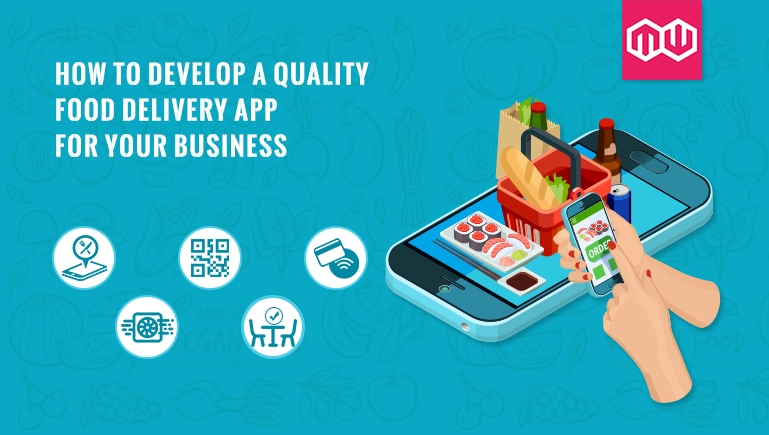With restaurant culture growing by leaps and bounds, it’s no surprise that food delivery app use is increasing among smartphone users, especially among young generation.
Why people choose to use a food delivery app is that not everyone enjoys dining out and would rather stay at home and eat at their leisure. This is especially useful for elderly people who have a strong desire for variety but are unable to leave their homes due to health concerns.

Want to know more about food ordering app development?
For Customers: This application (or user interface) is designed for restaurant customers who want to review the menu, order and pay for food, and report and monitor complaints.
For restaurants: This app aids in the management of inventory, menus, and pricing strategies, as well as the promotion of special offers.
For Delivery: This section assists the delivery team in contacting clients, locating locations and routes, and tracking the status of deliveries.
If an aggregator owns the food delivery app, they manage the majority of the management and backend, and restaurants sign up to use it. In such situations, they use their apps to bind the customer’s demand to the restaurant.
Want to build your own food delivery app for your restaurant business?
A couple of things needed before moving forward with developments:
Learn about the most important market trends.
Trends play a big role in the food distribution industry. People are drawn to “hot” apps with well-known features. You’ll lose customers if you don’t keep up with these features.
As a result, the first step is to determine what the consumer desires. What features do today’s customers like in food delivery apps? Integration of social media, virtual assistants, and smart watches are only a couple of the areas to consider.
Choose a delivery method
Order-only and order-and-delivery are the two most popular food delivery types. Your organization is solely responsible for ordering and handling orders in an order-only model. You are not in charge of delivery.
Meanwhile, order-and-delivery services handle all orders and deliveries. As a result, you can need to hire a delivery team or work with a courier service to get your orders delivered.
Do some market research on your target market
You want to build an app that caters to your target market’s requirements. As a result, start by figuring out what they’re looking for. At the very least, record the audience’s demographics, with age, gender, nationality, and income being the most important factors.
Determine the app features that are most important
There are a few simple features in any food delivery app. Registration and login is two of them. Will consumers, for example, log in using social media? Another important factor to remember is the quest ordering, payment alerts, order monitoring, feedback, and ratings are all important features.
Choose appropriate technologies for development
For different features, you’ll need best technologies. For example, if you want to list restaurants, you’ll need the Grubhub API or the FourSquare API. Secured payment gateways that are widely used to receive and process payments.
Then there’s the technology for determining a user’s position. Google Maps, Google Places API, and the Core location framework are all excellent choices.
Tips & best practices for developing “Food Delivery Apps”
After you’ve finished designing, it’s time to start developing. The following suggestions and best practices should assist you in creating a long-lasting app:
Utilize user feedback to improve UI friendliness
It’s impossible to use objective criteria to assess the usability of a user interface. Instead, try forming small focus groups and observing where people look, what buttons they push, and other such things. This will assist you in creating a more usable user interface.
You need a user interface that is easy and clutter-free
A more user-friendly admin interface would allow you to complete more tasks in less time. It has two meanings. For starters, you can process more orders every minute. Second, faster order delivery leads to greater customer loyalty, which leads to more repeat business!
All business metrics should be defined and tracked
Anything that generates revenue, particularly long-term processes, must be recorded in the database and meticulously tracked. The amount of orders processed every day, as well as returned orders, restaurant rejections, and average delivery time, must all be kept track of.
Keep track of the technological metrics
Tech metrics include items like how long it takes a daily user to place an order and how many app visitors abandon their carts without placing an order. Even, are people familiar with the navigation system? How long do they spend searching for the things they require?
Keep a record of everything
When there’s a problem, logs are particularly useful. You can easily trace the root of the problem if you have logs for anything. So, keep track of everything: what you send to the network, what you receive from the network, and the divisions of your algorithms.
Develop effective documents
Finally, just as critical as the app it is the documentation. Diagnosing problems in the app becomes almost impossible without adequate documentation. As a result, create thorough documentation and keep it up to date at all times.
Final Thoughts
Keep in mind that for both iOS and Android App Development is a completely different experience. Even testing and debugging can be difficult, so recruit mobile app developers from a reputable food delivery app development business.
MobiWeb Creations will assist you…
Our experience developing IT technologies for companies gives us a leg up on the competition when it comes to creating new applications of all kinds. Allow us to assist you in planning and developing the ideal food delivery app for your company, so you can hit the ground running.
